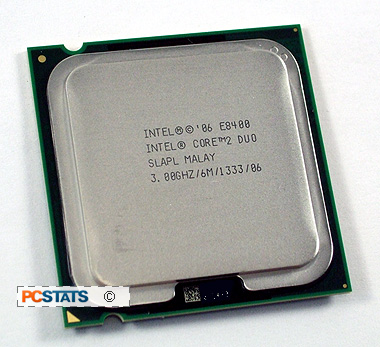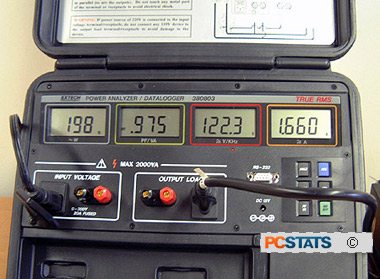 Gone are the days when performance benchmarks settled all Intel
vs. AMD processor debates. Energy efficiency is in, and if electrical bills
don't motivate you then reduced heat output and quieter cooling system will
certainly make your head turn
Gone are the days when performance benchmarks settled all Intel
vs. AMD processor debates. Energy efficiency is in, and if electrical bills
don't motivate you then reduced heat output and quieter cooling system will
certainly make your head turn
Wading through the technical numbers to figure out
the differences can be confusing because Intel and AMD report power values in
slightly different ways. On paper AMD lists its processors maximum
power TDP value, while Intel posts typical Thermal Design Power
figures.
Obviously the two measurements of processor power
consumption are not quite directly comparable, so to find out how processors
stack up in the power efficiency department we need to measure how much power
the computer draws while idle, then while in a CPU-stressed state.
To get a more accurate indication of what speeds
the processors are currently running at, PCSTATS first disabled a bunch of AMD
and Intel's power saving and CPU clock speed throttling technologies like Cool
'n' Quiet, EIST (speedstep) and C1E power states.
 To simulate single-core load a program
called Stress Prime (SP2004) is used. PCSTATS
set about stressing each processor from one to all cores. This programs gives
better insight
into different power draw scenarios. The SP2004 program is multi-threaded, allowing individual
CPU cores to be stressed by each instance of the program.
To simulate single-core load a program
called Stress Prime (SP2004) is used. PCSTATS
set about stressing each processor from one to all cores. This programs gives
better insight
into different power draw scenarios. The SP2004 program is multi-threaded, allowing individual
CPU cores to be stressed by each instance of the program.
Total system power consumption was read with the Extech
Power Analyzer Datalogger (model 380803) for both CPU loaded and CPU idle
states. These values are measuring an entire system
while the processor is running under computational load or idle.
The Extech Power Analyzer is located between the main 120AC supply and the PC's
power supply. Given that motherboards vary across these test
systems this is not a "true" measure of CPU power draw alone, but rather a
measurement of the total computer system power draw, which we can compare for
each specific platforms between the CPU idle and CPU stressed states.
| Total System Idle
Power Draw |
| Processor |
Total System Power Draw |
| Intel Pentium 4 540 |
   150 Watts 150 Watts |
| Intel Pentium D 840 |
   165 Watts 165 Watts |
| Intel Pentium D 940 |
   168 Watts 168 Watts |
| Intel Core 2 Duo E6600 |
   117 Watts 117 Watts |
| Intel Core 2 Duo E6750 |
   123 Watts 123 Watts |
 Intel Core 2 Duo E8400 Intel Core 2 Duo E8400 |
   131 Watts 131 Watts |
| Intel Core i7 920 |
   144
Watts 144
Watts |
| AMD Sempron 3600+ |
   120 Watts 120 Watts |
| AMD Athlon64 4000+ |
   163 Watts 163 Watts |
| AMD Athlon64 FX-60 |
   127 Watts 127 Watts |
| AMD Athlon64 X2 4800+ |
   143 Watts 143 Watts |
| AMD Athlon64 X2 5000+ |
   156 Watts 156 Watts |
| AMD Athlon64 FX-62 |
   168 Watts 168 Watts |
| AMD Phenom II X3 720 |
   155 Watts 155 Watts |
| AMD Phenom II X4 955 |
   148
Watts 148
Watts |
At idle
the Intel Core 2 Duo E8400 system isn't able to take a whole lot of advantage of its
smaller 45nm manufacturing node, which means it draws a few Watts more
than the Intel Core 2 Duo E6600 and E6750. The larger AMD processors have difficulty keeping up
with the Core 2 Duo processors, as they're still manufactured on larger 90nm or 65nm
processes.
| Total System
Stressed Power Draw - All Cores/Threads |
| Processor |
Total System Power Draw (All Cores) |
| Intel Pentium 4 540 |
   223 Watts 223 Watts |
| Intel Pentium D 840 (2 Core ) |
   240 Watts 240 Watts |
| Intel Pentium D 940 (2 Core Load) |
   253 Watts 253 Watts |
| Intel Core 2 Duo E6600 (2 Core Load) |
   156 Watts 156 Watts |
| Intel Core 2 Duo E6750 (2 Core Load) |
   163 Watts 163 Watts |
 Intel Core 2 Duo E8400 (1 Core
Load) Intel Core 2 Duo E8400 (1 Core
Load) |
   152 Watts 152 Watts |
 Intel Core 2 Duo E8400 (2 Core
Load) Intel Core 2 Duo E8400 (2 Core
Load) |
   158 Watts 158 Watts |
| Intel Core i7 920 (8 Thread Load) |
   213
Watts 213
Watts |
| AMD Sempron 3600+ |
   148 Watts 148 Watts |
| AMD Athlon64 4000+ |
   172 Watts 172 Watts |
| AMD Athlon64 FX-60 (2 Core Load) |
   196 Watts 196 Watts |
| AMD Athlon64 X2 4800+ (2 Core Load) |
   173 Watts 173 Watts |
| AMD Athlon64 X2 5000+ (2 Core Load) |
   207 Watts 207 Watts |
| AMD Athlon64 FX-62 (2 Core Load) |
   235 Watts 235 Watts |
| AMD Phenom II X3 720 (3 Core Load) |
   213
Watts 213
Watts |
| AMD Phenom II X4 955 (4 Core Load) |
   236
Watts 236
Watts |
With one processing core running at full load the
system consumes 152W of power. The only test system that uses less is the one
equipped with an Intel Core 2 Duo E6600 and the 65W AMD Sempron 3600+ processor.
In comparison, an ancient Pentium D 940 CPU system pulls a mind-blowing 230W of
power while the Athlon64 FX-62 is no saint either at 196W!
Here the wattage starts to ramp up, and now even though the Core 2 Duo E8400 is clocked at faster speeds and gives better performance, it still managed
to draw only 158W under load, less power than the Core 2 Duo
E6750 when both cores are stressed. Really, the only processors that are drawing
less power are the Core 2 Duo E6600 and AMD's
entry-level Sempron 3600! Intel's renewed focus on energy-efficiency is really paying
off here.
Now to the fun stuff, 1333MHz FSB processor overclocking!
